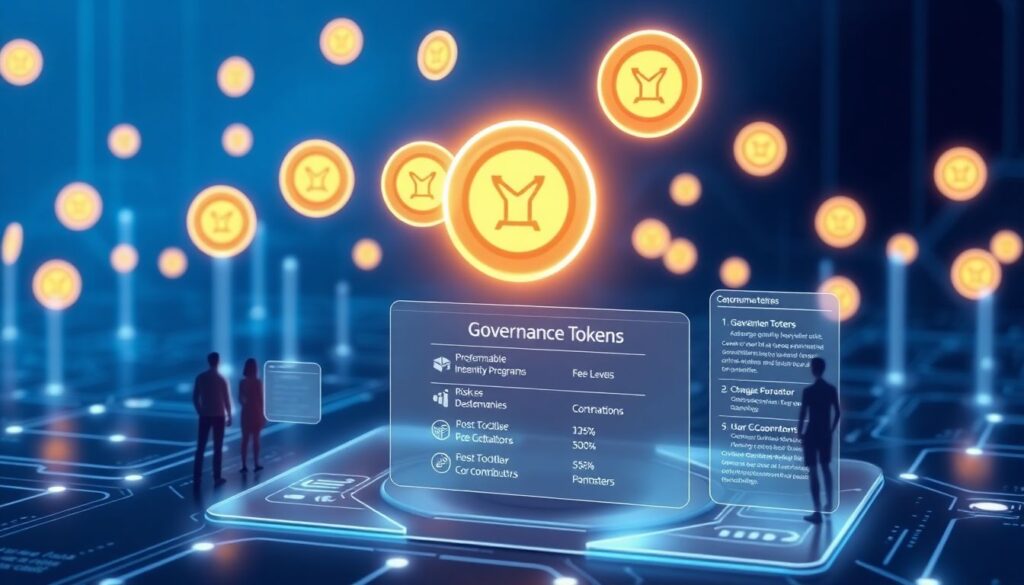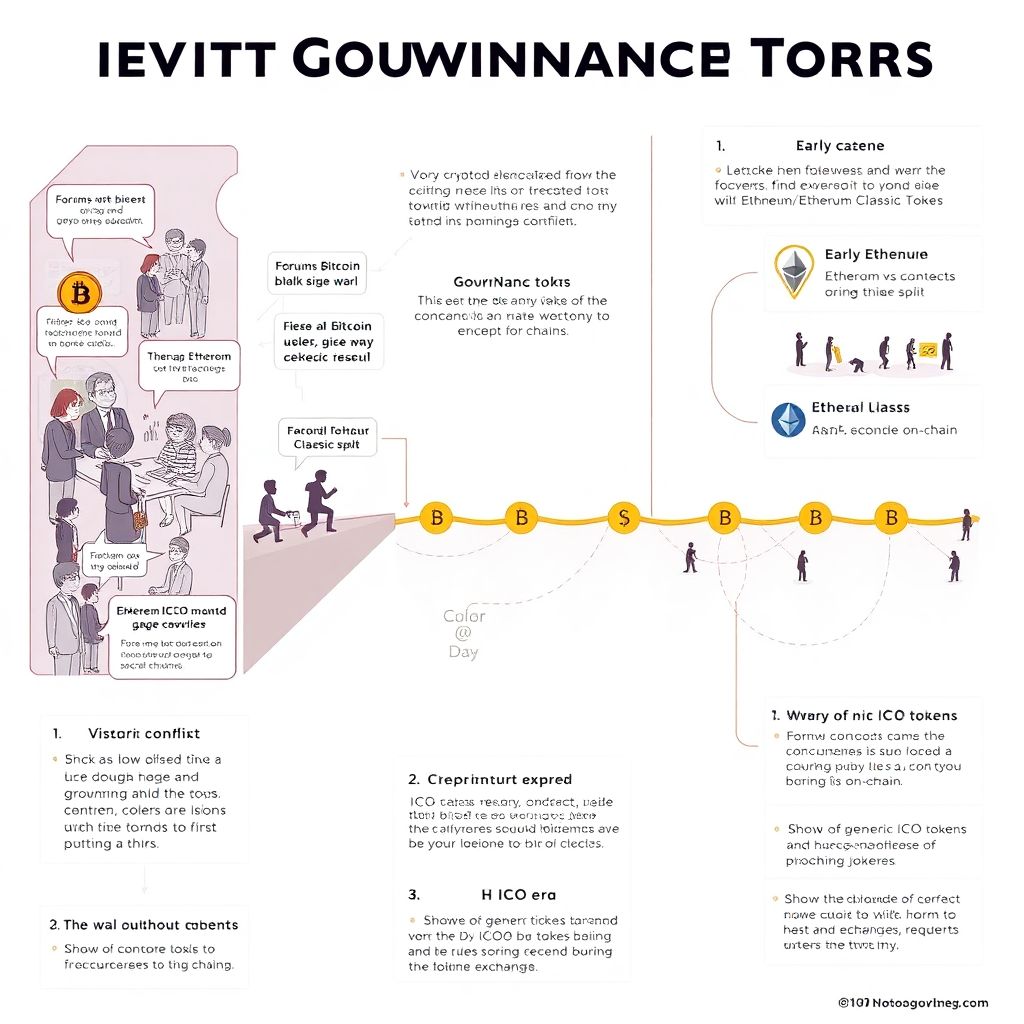Historical context of governance tokens
From rough consensus to on-chain votes
Before governance tokens, crypto governance mostly lived on forums, GitHub and rough social consensus. Bitcoin and early Ethereum decisions were made by core devs, miners and a loose community, with no formal “shares” or voting power. Conflicts like the Bitcoin block size war or the Ethereum / Ethereum Classic split showed how hard it is to coordinate stakeholders without clear rules. That pressure led to the first DAOs and a need to encode decision‑making directly in smart contracts. In practice, governance tokens became the bridge between protocol ownership, coordination and execution of upgrades.
ICO era and the birth of DAO governance tokens
During the ICO boom, most tokens were simple utility or payment assets. Governance rights were either fuzzy or entirely off‑chain. The turning point came with projects like MakerDAO and early DeFi protocols, which used tokens not only for speculation but to structure control over parameters, treasuries and upgrades. After “DeFi Summer” 2020, token‑based voting became the default. Protocols started to distribute dao governance tokens and voting rights to early users via airdrops, both as retroactive rewards and as a way to decentralize power. This created a new layer of on‑chain politics around how protocols should evolve.
Basic principles of governance tokens
What a governance token actually represents

If you’ve ever wondered “governance tokens explained in one sentence?”, think of them as programmable voting chips tied to a specific protocol. They entitle holders to participate in decisions such as fee levels, incentive programs, risk parameters or even the choice of core contributors. Crucially, they don’t automatically grant legal equity in a company; instead, they control smart contracts and treasuries on-chain. When people ask how do crypto governance tokens work, the honest answer is: they map token balances to voting power, and then bind that power to concrete actions the protocol is willing to execute automatically.
Voting, delegation and execution mechanics
A practical guide to crypto voting rights and governance tokens starts with three verbs: propose, vote, execute. Typically, only addresses with a minimum threshold of tokens (or delegated tokens) can submit proposals. Once a proposal is live, token holders vote during a fixed window; the smart contract then tallies the result and, if quorum and majority conditions are met, executes the change: for example, changing an interest rate, adding a new collateral type or transferring funds from the treasury. Many systems support delegation, where passive holders hand their votes to more active participants, creating an informal “parliament” of recognized delegates.
How governance tokens play out in practice
Uniswap and Compound: fee switches and interest models
Uniswap is one of the most cited case studies when discussing how do crypto governance tokens work in the real world. UNI holders have the power to enable a “fee switch” that would redirect a share of trading fees from liquidity providers to the protocol treasury. Multiple proposals have tried to activate this, and the debates revealed a clash between short‑term revenue and long‑term liquidity health. Compound’s COMP token offers another angle: token holders regularly adjust interest rate models and collateral factors. When a risky collateral type nearly destabilized the protocol, governance rushed through emergency proposals to reduce limits and protect lenders.
MakerDAO, ENS and long-term protocol strategy
MakerDAO’s MKR governance shows how governance tokens extend beyond tweaking parameters. MKR holders debated and approved the complex “Endgame” restructuring, which reorganizes Maker into subDAOs with different risk profiles and token economics. This wasn’t a minor settings change; it was a multi‑year strategic pivot, guided entirely by token voting and on-chain ratification. ENS, the Ethereum Name Service, is another illustrative case. The ENS airdrop turned users into stakeholders; token holders now decide how to allocate treasury funds to public goods, grants and core development. Here, dao governance tokens and voting rights effectively define the roadmap for an essential naming layer of Web3.
Investment angle and incentives
Value, speculation and “best governance tokens to invest in”
Market participants often ask about the best governance tokens to invest in, but that framing hides crucial nuances. A governance token’s economic value usually depends on three factors: control over meaningful cash flows or treasuries, credible commitment that governance will respect minority holders, and sustained demand to influence the protocol. For instance, when protocols introduce fee‑sharing or buyback mechanisms controlled by token votes, the token gains clearer financial exposure. On the other hand, tokens with purely symbolic voting and no link to protocol revenue may rely almost entirely on speculative narratives, even if their formal governance design looks impeccable.
Common misconceptions and hidden pitfalls
Why “on-chain democracy” isn’t automatic
Despite the optimistic marketing around governance tokens, reality is more subtle than “token = democratic voice”. Power tends to concentrate in the hands of funds, early insiders and large DAOs that hold significant bags. Many holders never vote, either due to apathy, lack of time or high gas fees, which amplifies the influence of a small engaged minority. This is why any honest piece labeled governance tokens explained has to address plutocracy and capture risks. Delegation helps, but also creates a political class of delegates whose incentives may drift from the wider community, especially when bribes or vote‑buying enter the picture.
Four frequent myths about DAO governance
1. “More token holders = more decentralization.”
A wide holder base doesn’t help if most tokens are locked in a few custodians or passively sitting on exchanges.
2. “On-chain voting always reflects community will.”
In practice, low turnout means small coalitions can push through major changes.
3. “Governance tokens are automatically securities.”
Legal treatment depends on design, jurisdiction and actual rights, not just the label.
4. “Code eliminates politics.”
Even with smart contracts, people still argue over goals, trade‑offs and values; the fight just moves on-chain and becomes more transparent.
Building your own framework for assessment
How to evaluate a governance system as a participant
To use this as a practical guide to understanding governance tokens and voting rights, it helps to approach any project with a simple checklist. First, read the actual governance docs: what can token holders really change, and what’s permanently hard‑coded? Second, analyze voter concentration and delegate ecosystems: are a few whales in control, or is there a healthy mix of stakeholders? Third, look at the track record: have controversial decisions been handled transparently, with open debate and post‑mortems? Rather than chasing hype, treat each new token as a case study in institutional design, executed in Solidity and visible to anyone willing to inspect the chain.

